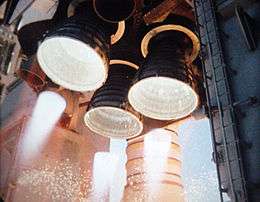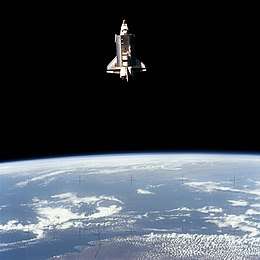Space Shuttle launch countdown
The launch of Space Shuttle missions was governed by a countdown. Two clocks were maintained, the unofficial, but sometimes mentioned, L (launch) clock represented the time remaining before the scheduled launch in real time, and the more often referred to T (test) clock included several built-in holds where additional verifications were made. Built-in holds were extended if mission parameters allowed for additional checks or to correct issues. Launches of the Space Shuttle to the International Space Station did not allow for holds to be extended due to the launch window which was limited to no more than 10 minutes due to the 90 minute orbit period of the station and speed of Earth's rotation (913.6 miles per hour (1,470.3 km/h) at the Kennedy Space Center[1]), which puts the launch pads 1,000 miles (1,600 km) east of the station on its next orbit.[2][3][4][5]

Milestones
- Call to stations, ~72 hours before launch time
T-43 hours and counting
- Begin final vehicle and facility close-outs for launch
- Check out backup flight systems
- Review flight software stored in mass memory units and display systems
- Load backup flight system software into the orbiter's general purpose computers
- Remove middeck and flight deck platforms
- Activate and test navigational systems
- Complete preparation to load power reactant storage and distribution system
- Complete flight deck preliminary inspections
T-27 hours and holding
- This was the first built-in hold and typically lasted four hours.
- Clear launch pad of all non-essential personnel
- Begin loading cryogenic propellants into orbiter's power reactant storage and distribution (PRSD) system
T-27 hours and counting
- Begin loading of cryogenic reactants into the orbiter's fuel cell storage tanks
T-19 hours and holding
This built-in hold typically lasted four hours, but was extended if PRSD offload is required. During this hold:
- Demate the orbiter's midbody umbilical unit
- Clean and vacuum crew module
- External tank nosecone purge
T-19 hours and counting
- Begin final preparations of the orbiter's three main engines for main propellant tanking and flight
- Fill launch pad sound suppression system water tank
- Resume orbiter and ground support equipment close-outs
- Close out the tail service masts on the mobile launcher platform
T-11 hours and holding
This built-in hold varied between 13 and 14 hours.
- Weather and engineering briefings
- Pad debris inspection and closeout
- Flight crew equipment late stow
- Move rotating service structure to "park" position
- Activate the orbiter's inertial measurement units and communications systems
- Perform ascent switch list
T-11 hours and counting
- Activate the orbiter's fuel cells
- Clear the blast danger area of all nonessential personnel
- Switch the orbiter's purge air to gaseous nitrogen
T-6 hours and holding
This built-in hold typically lasted two hours, or one hour for a 24- or 48-hour scrub. Countdown may be resumed at this point after a 24‑hour scrub/turnaround.
- Mission Management Team and launch director receive weather update
- Launch team verifies no violations of launch commit criteria before loading the external tank with propellants
- Chill-down of propellant transfer lines
- Begin "tanking", loading the external tank with about 500,000 US gallons (1,900 m3) of cryogenic propellants
T-6 hours and counting
- The external tank was inspected for frost and debris
- The external tank was checked for concentration of H2 around the orbiter
- Finish filling the external tank with its flight load of liquid hydrogen and liquid oxygen propellants
T-3 hours and holding
This built-in hold typically lasted two-and-a-half hours.
- External tank loading enters stable replenish
- Perform inertial measurement unit preflight calibration
- Align Merritt Island Launch Area (MILA) tracking antennas
- Final Inspection Team proceeds to the launch pad to conduct a detailed analysis of the vehicle as the team walks up and down the entire launch tower
- Closeout Crew proceeds to the launch pad to configure the crew module for countdown and launch and assist the astronauts with entry into the orbiter
- Televised weather briefing
- Flight crew weather briefing
- Astronaut Support Person enters crew module and begins comm checks
T-3 hours and counting
- Crew departs for the launch pad and, upon arriving at the pad, begins entry into the orbiter via the White Room
- Complete close-out preparations in the launch pad's White Room
- Check cockpit switch configurations
- Astronauts perform air-to-ground voice checks with Launch Control (Kennedy Space Center) and Mission Control (Johnson Space Center)
- Close the orbiter's crew hatch and check for leaks
- Complete White Room close-out
- Close-out crew retreats to fallback area
T-20 minutes and holding
This built-in hold typically lasted 10 minutes.
- NASA Test Director conducts final launch team briefings
- Complete inertial measurement unit preflight alignments
T-20 minutes and counting
- Once the countdown resumed, the orbiter's onboard computers transition to launch configuration
- Start fuel cell thermal conditioning
- Close orbiter cabin vent valves
- Transition backup flight system to launch configuration
T-9 minutes and holding
This was the final built-in hold, and varied in length depending on the mission.
- During the hold, final launch window determination
- Activate flight recorders
- Final "go/no-go" launch polls conducted by NASA Test Director, Mission Management Team and Launch Director
T-9 minutes and counting
- Once the countdown resumed, start automatic ground launch sequencer
- Retract orbiter access arm (T-7 minutes, 30 seconds)
T-5 minutes and counting
- Start auxiliary power units (APUs)
- Arm solid rocket booster range safety safe and arm devices
- Start orbiter aerosurface profile test, followed by main engine gimbal profile test (T-3 minutes, 55 seconds)
- Retract gaseous oxygen vent arm, or "beanie cap" (T-2 minutes, 50 seconds)[6]
- Crew members close and lock their visors (T-2 minutes, 0 seconds)
- Orbiter transfers from ground to internal power (T-50 seconds)
- Ground launch sequencer is go for auto sequence start (T-31 seconds)
- Activate launch pad sound suppression system (T-16 seconds)
T-10 seconds and counting
- Activate main engine hydrogen burnoff system (T-10 seconds)
- Ground launch sequencer commands main engine start (T-6.6 seconds)
T-0 seconds
- Solid Rocket Boosters ignite
- Explosive bolts release the boosters
- Shuttle stack lifts off from launch pad
References
- Butterworth, Paul. "Speed of the Earth's Rotation". NASA.
- Adams, Eric (March 2002). "How Things Work: Shuttle Launch Windows". Air and Space. Archived from the original on 2012-07-17.
- "LAUNCH COUNTDOWN FOR SHUTTLE MISSION STS-97 BEGINS 1 A.M. NOV. 28". NASA. Archived from the original on 2011-04-16.
- "Space Shuttle Launch Countdown". NASA.
- "Countdown 101". NASA.
- "Space Shuttle Launch Countdown". ksc.nasa.gov. Retrieved 2016-12-09.


